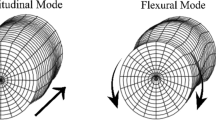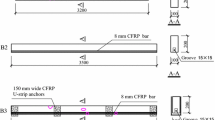Abstract
Guided stress waves are considered one of the most efficient and reliable techniques that provide sufficient quantitative and qualitative assessment. In this study, we focused on scrutinizing the propagation behavior of guided waves in western white pine timber poles, experimentally, and numerically using COMSOL Multiphysics. Macro fiber composites (MFCs), due to their flexibility and convenience to install on curved profiles, were used to actuate and sense guided waves along the tested specimens. Various solutions for wave mode tuning and characterization have been tested for traction free and embedded boundary conditions. The behavior of propagating wave modes was analyzed and compared in the two boundary conditions tested. Also, the excitation frequency, based on the dispersion curves generated for transversely isotropic timber, was selected to ensure the presence of favorable propagating (for instance longitudinal modes) modes with minimal dispersion. Undesirable wave modes—such as flexural modes (non-axisymmetric)—were eliminated by a ring design composed of multiple MFC actuators coupled around the pole’s circumference. The remaining propagating longitudinal modes and their reflections, such as modes L(0,1) and L(0,2) propagating at nearly 1000 m/s and 800 m/s respectively, were significantly enhanced by the actuation of the ring which could be effectively used for the assessment process. The results demonstrated the complexity of the propagating modes in circular timber structures and the importance of the ring design in the excitation of the selected modes of interest and damping unwanted ones.






















Similar content being viewed by others
References
DeGarmo EP, Black JT, Kohser RA, Klamecki BE (1997) Materials and process in manufacturing, 9th edn. Prentice Hall, Upper Saddle River
Dinwoodie J (1975) Timber—a review of the structure-mechanical property relationship. J Microsc 104(1):3–32
Marquardt R (2012) Extending Wood Pole Life With Remedial Preservatives. https://www.utilityproducts.com/home/article/16002834/extending-wood-pole-life-with-remedial-preservatives. Accessed 1 November 2018
Dackermann U, Crews K, Kasal B, Li J, Riggio M, Rinn F, Tannert T (2014) In situ assessment of structural timber using stress-wave measurements. Mater Struct 47(5):787–803
Li J, Subhani M, Samali B (2012) Determination of embedment depth of timber poles and piles using wavelet transform. Adv Struct Eng 15(5):759–770
Senalik AC, Schueneman G, Ross RJ (2014) Ultrasonic-based nondestructive evaluation methods for wood: a primer and historical review. U.S. Department of Agriculture, Forest Products Laboratory, Madison, WI, pp 1–36
Krause M, Dackermann U, Li J (2015) Elastic wave modes for the assessment of structural timber: ultrasonic echo for building elements and guided waves for pole and pile structures. J Civil Struct Health Monit 5(2):221–249
Divףs F, Dבniel I, Bejף L (2001) Defect detection in timber by stress wave time and amplitude. NDT 6:3s
Wang X, Divos F, Pilon C, Brashaw BK, Ross RJ, Pellerin RF (2004) Assessment of decay in standing timber using stress wave timing nondestructive evaluation tools: a guide for use and interpretation. U.S. Department of Agriculture, Forest Products Laboratory, Madison, WI
Subhani M (2014) A Study on the Behaviour of Guided Wave Propagation in Utility Timber Poles. University of Technology Sydney, Ulyimo
Dos Santos JA (2008) The application of stress-wave theory to piles: science, technology and practice. In: Proceedings of the 8th International Conference on the Application of Stress-Wave Theory to Piles, 8–10 September 2008. IOS Press, Lisbon
Seco F, Jiménez AR (2012) Modelling the generation and propagation of ultrasonic signals in cylindrical waveguides. In: Sanyos A Jr. (ed) Ultrasonic waves. InTechOpen, pp 1–28. https://doi.org/10.5772/1411
Gazis DC (1959) Three-dimensional investigation of the propagation of waves in hollow circular cylinders. I. Analytical foundation. J Acoust Soc Am 31(5):568–573
Rose JL (2014) Ultrasonic guided waves in solid media. Cambridge University Press, Cambridge
Subhani M, Li J, Samali B (2013) A comparative study of guided wave propagation in timber poles with isotropic and transversely isotropic material models. J Civil Struct Health Monit 3(2):65–79
Subhani M, Li JC, Gravenkamp H, Samali B (2013) Effect of elastic modulus and poisson's ratio on guided wave dispersion using transversely isotropic material modelling. Adv Mater Res 778:303–311. https://doi.org/10.4028/www.scientific.net/amr.778.303
Green DW, Winandy JE, Kretschmann DE (1999) Wood handbook: wood as an engineering material. U.S. Department of Agriculture, Forest Products Laboratory, Madison, WI, pp 41–445
Cavalli A, Cibecchini D, Togni M, Sousa HS (2016) A review on the mechanical properties of aged wood and salvaged timber. Constr Build Mater 114:681–687
Subhani M, Li J, Samali B, Crews K (2016) Reducing the effect of wave dispersion in a timber pole based on transversely isotropic material modelling. Constr Build Mater 102:985–998
Subhani M, Li J, Samali B (2016) A study of guided wave propagation in timber pole using spectral finite element method. In: 19th World Conference on Non-Destructive Testing (WCNDT 2016). NDT.net, Munich, pp 2242–2251
Subhani M, Li J, Samali B, Yan N (2013) Determination of the embedded lengths of electricity timber poles utilising flexural wave generated from impactí. Austr J Struct Eng 14(1):85–96
Yu Y, Yan N (2017) Numerical study on guided wave propagation in wood utility poles: finite element modelling and parametric sensitivity analysis. Appl Sci 7(10):1063
Yan N, Li J, Dackermann U, Samali B (2013) Numerical and experimental investigations of stress wave propagation in utility poles under soil influence. In: From materials to structures: advancement through innovation-proceedings of the 22nd Australasian Conference on the Mechanics of Structures and Materials, ACMSM 2012
Pavlakovic B, Lowe M (2003) Disperse Software Manual Version 2.0. 1 6B. Imperial College, London
Elishakoff I (2007) Mechanical vibration: where do we stand?, vol 488. Springer, New York
Kretschmann DE (2010) Mechanical properties of wood. In: Wood handbook: wood as an engineering material, vol 113. Forest Products Laboratory, Wisconsin, pp 5.1–5.46
Winston HA, Sun F, Annigeri BS (2001) Structural health monitoring with piezoelectric active sensors. J Eng Gas Turbines Power (Trans ASME) 123(2):353–358
Thien AB (2006) Pipeline structural health monitoring using macro-fiber composite active sensors. Dissertation, University of Cincinnati, United States
Multiphysics COMSOL (1998) Introduction to COMSOL Multiphysics. In: COMSOL. https://cdn.comsol.com/doc/5.5/IntroductionToCOMSOLMultiphysics.pdf. Accessed 19 Feb 2018
Steiger K, Mokrý P (2015) Finite element analysis of the macro fiber composite actuator: macroscopic elastic and piezoelectric properties and active control thereof by means of negative capacitance shunt circuit. Smart Mater Struct 24(2):025026
Subhani M, Li J, Samali B (2016) Separation of longitudinal and flexural wave in a cylindrical structure based on sensor arrangement for non-destructive evaluation. J Civil struct Health Monit 6(3):411–427
Marburg S (2002) Six boundary elements per wavelength: Is that enough? J Comput Acoust 10(01):25–51
Mustapha S, Ye L (2014) Leaky and non-leaky behaviours of guided waves in CF/EP sandwich structures. Wave Motion 51(6):905–918
Lovelace WR (2005) The wood pole 2005: Design considerations, service benefits, and economic reward. Hi-Line Engineering, LLC, Tech Rep
Duan W, Liao X, Jin J, Wang Y (2001) Numerical modeling of pile-soil interface and numerical analysis of single pile QS curve. J Harbin Univ Civil Eng Archit 5
Vanlangen H (1991) Numerical analysis of soil-structure interaction. Doctoral Thesis, Technische Univ., Delft. Geotechnical Lab., The Netherlands
Zhang G, Zhang J-M (2009) Numerical modeling of soil–structure interface of a concrete-faced rockfill dam. Comput Geotech 36(5):762–772
Potts DM, Zdravkovic L, Addenbrooke TI, Higgins KG, Kovacevic N (2001) Finite element analysis in geotechnical engineering: application, vol 2. Thomas Telford, London
Bieker D, Rust S (2010) Non-destructive estimation of sapwood and heartwood width in Scots pine (Pinus sylvestris L.). Silva Fennica 44(2):267–273
Mergny E, Mateo R, Esteban M, Descamps T, Latteur P (2016) Influence of cracks on the stiffness of timber structural elements. In: World Conference on Timber Engineering (WCTE 2016). Vienna, pp 1–10
Colominas MA, Schlotthauer G, Torres ME (2014) Improved complete ensemble EMD: a suitable tool for biomedical signal processing. Biomed Signal Process Control 14:19–29
Fakih MA, Mustapha S, Tarraf J, Ayoub G, Hamade R (2018) Detection and assessment of flaws in friction stir welded joints using ultrasonic guided waves: experimental and finite element analysis. Mech Syst Signal Process 101:516–534
Acknowledgements
We acknowledge the financial support of the University Research Board at the American University of Beirut for their Award #103780.
Author information
Authors and Affiliations
Corresponding author
Additional information
Publisher's Note
Springer Nature remains neutral with regard to jurisdictional claims in published maps and institutional affiliations.
Rights and permissions
About this article
Cite this article
El Najjar, J., Mustapha, S. Understanding the guided waves propagation behavior in timber utility poles. J Civil Struct Health Monit 10, 793–813 (2020). https://doi.org/10.1007/s13349-020-00417-0
Received:
Revised:
Accepted:
Published:
Issue Date:
DOI: https://doi.org/10.1007/s13349-020-00417-0




